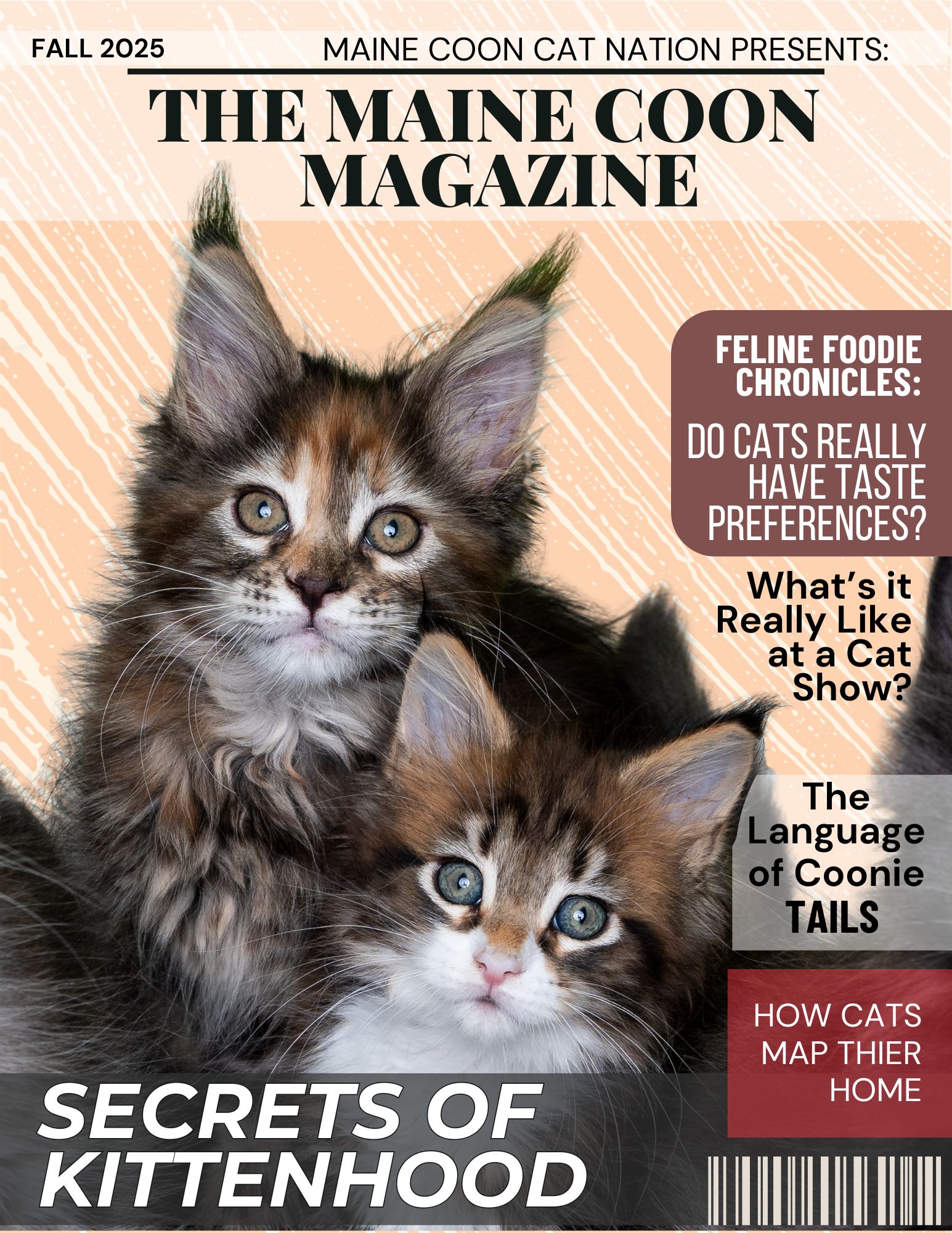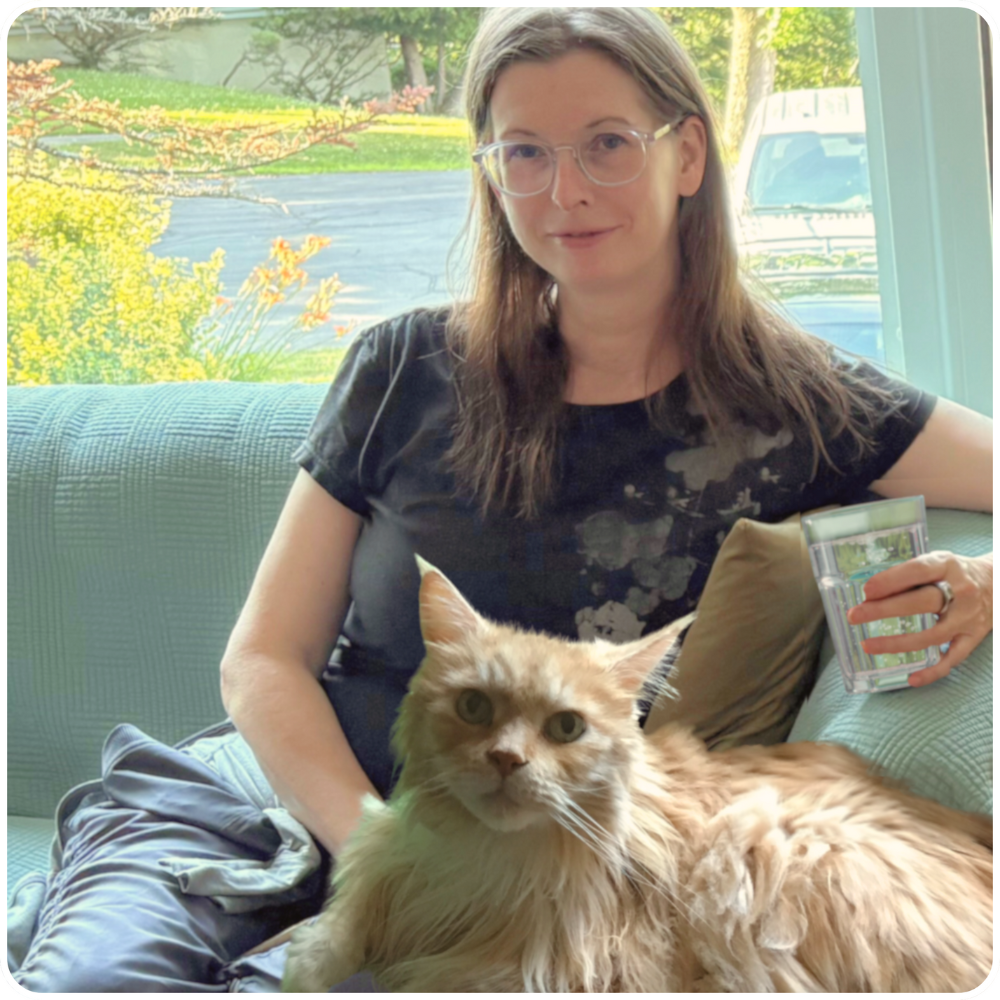- Home
- About Maine Coon Cats
- Activity Level & Exercise Needs
Maine Coon Activity Level, Exercise & Enrichment
A while back, Roxanne from Ottawa wrote in with this question:
"I'm working on a project featuring the Maine Coon for my veterinary technician university course and I'm looking for any information you might have regarding the daily activity level this breed requires to keep in shape and what to expect.
I hope that you can provide me with some information. Thank you in advance for your help."
It's a great question, and one that still comes up from time to time in our Cat Questions section.
The truth is, Maine Coons aren't known for having a unique "activity level" that sets them apart from other cats.
They're energetic as kittens, mellow as adults, and happiest when they have a mix of playtime and downtime.
If you like this, you'll love our fun, free Daily Digest!

What does make them special is how engaged they are with their people.
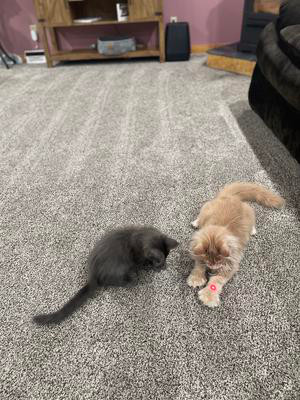 Boris & Grace, from our 2022 Albums - playing with a laser pointer
Boris & Grace, from our 2022 Albums - playing with a laser pointerThat famous Maine Coon energy level can range from laid-back to full-throttle play.
They might not sprint through the house all day, but they’ll follow you from room to room, help you fold laundry, or chase a toy with full enthusiasm when the mood strikes.
And because they're large, it's worth paying attention to how much exercise they get - keeping their weight healthy helps protect their joints and hips later in life.
Let's take a closer look at what "normal" activity looks like for these gentle giants, and how to keep them happy, fit, and mentally sharp.
Typical Maine Coon Activity Level
Let's get right to it! Yes, Maine Coons are active cats, especially when they're young.
Kittens and young adults have plenty of energy to burn, and they'll do it in bursts that usually involve running full-speed through the house, chasing toys, or each other.
If you have stairs, expect to hear the occasional thunder of paws racing up and down.
Homes with wood floors might want to invest in a few area rugs (we did) - not only for traction during the zoomies, but to protect floors from marks.
They don't necessarily need constant entertainment, but they do need opportunities to move.
A tossed ball, a feather wand, or another pet in the household is often all it takes to spark a chase session that looks like organized chaos.
Once that's out of their system, they tend to flop wherever they land, in a very "work hard, nap hard" kind of balance!
Adult Maine Coons keep some of that playful spark, but their activity levels even out.
They still enjoy a daily play session, but they're just as happy to stretch out nearby and supervise your day instead of sprinting through it.
Indoor Life & Exercise Needs
Can a Maine Coon Live in a Small Home?
People often assume a big cat must need a big house, but that's not really the case. Maine Coons adjust beautifully to indoor life, whether it's a large home or a small apartment.
What matters most is that they feel part of the household and have a few good ways to move, climb, and play.
They're more people-focused than territory-focused. As long as they can follow you around, hop onto a perch, and keep an eye on what you're doing, they're content.
Those living in apartments often find that their cats adapt easily, with a few adjustments. You can see what that looks like in real life in our piece on life with a Maine Coon in a small home.
When it comes to exercise, this breed doesn't need hours of daily play, but they do benefit from regular movement.
A ten-minute feather-wand session, a short chase through the hallway, or even a climb up a tall cat tree can meet that need. The key is variety and routine rather than intensity.
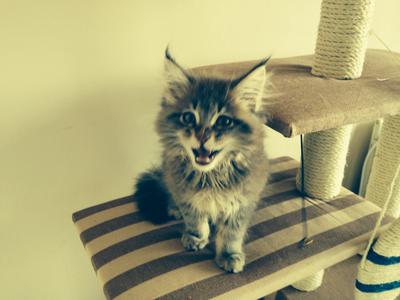 Little Bob, from our Rainbow Bridge Albums
Little Bob, from our Rainbow Bridge AlbumsKeeping them active indoors isn't just about burning calories. It helps with joint health, digestion, and mood.
You'll notice the difference in how relaxed and confident they act when they’ve had a good play session.
Can These Big Cats Live Indoors? Do They Need to Go Outdoors?
If you're on the fence about keeping your Coonie inside full-time, most experts, breeders and long-time owners agree it's the safest choice.
Indoor life protects against accidents and illness while still offering plenty of stimulation when done right.
You'll find more thoughts on that in our discussion about keeping Maine Coons indoors.
You can also read what other owners have shared about keeping cats content indoors - from leash training to outdoor enclosures - in our community tips on indoor cats.
5 Fresh Enrichment Ideas for Active Maine Coons
Even indoor-only cats can live rich, busy lives and get plenty of exercise. The enrichment ideas below have each been featured in our Daily Digest, where we share bite-sized tips and insights gathered from real Coonie households.
Every one of these ideas was handpicked for being practical, fun, and genuinely helpful. It's the kind of real-world experience that keeps our readers (and their cats!) inspired day after day.
If you enjoy this style of hands-on guidance, make sure you're on our email list - it's where we share our newest enrichment ideas first!
Here are some ways to keep your Coonie both mentally and physically sharp:
1. Window Scent Enrichment with Herbs
Felines don't just live by sight and sound. Their world is ruled by scent!
With over 200 million odor-sensitive cells (compared to our 5 million) and a special vomeronasal organ that "tastes" scent particles, every sniff delivers a packet of information.
That's why adding a little scent enrichment at your cat’s favorite window perch can be such a game-changer.
A pot of fresh herbs isn't just décor, it's fresh data for his brain.
Sniff-safe picks: rosemary, basil, thyme, valerian root, chamomile (German), cat thyme
Nibble-safe greens: cat grasses (wheat, oat, barley), parsley, cilantro, catmint
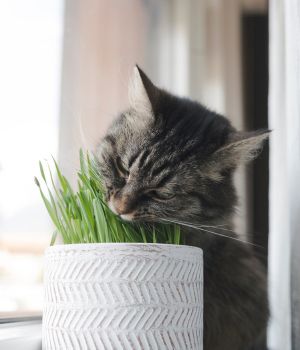
Rotate herbs every couple of weeks to keep scents novel, and always avoid essential oils or toxic herbs like pennyroyal, garlic family plants, and lavender.
Even something as simple as wheatgrass from the grocery store can turn a window perch into a sensory station.
Where to find them: Many grocery stores carry small pots of rosemary, thyme, or basil in the produce section.
Cat grass kits are easy to find at garden centers, farmer's markets - or you can grab a grow-your-own kit on Amazon.
2. Elevated Scratching
Most scratching posts sit neatly on the floor, but have you ever noticed your cat stretching up to rake claws at shoulder or head height?
That instinct is more than mischief. It reflects how felines in the wild leave their marks high on trees to signal presence and strength.
For large breeds like Maine Coons, reaching higher also feels natural. Their long bodies and strong shoulders make wall-height scratching a better stretch than a short floor post can provide. It is part workout exercise, part message board, and part stress relief.
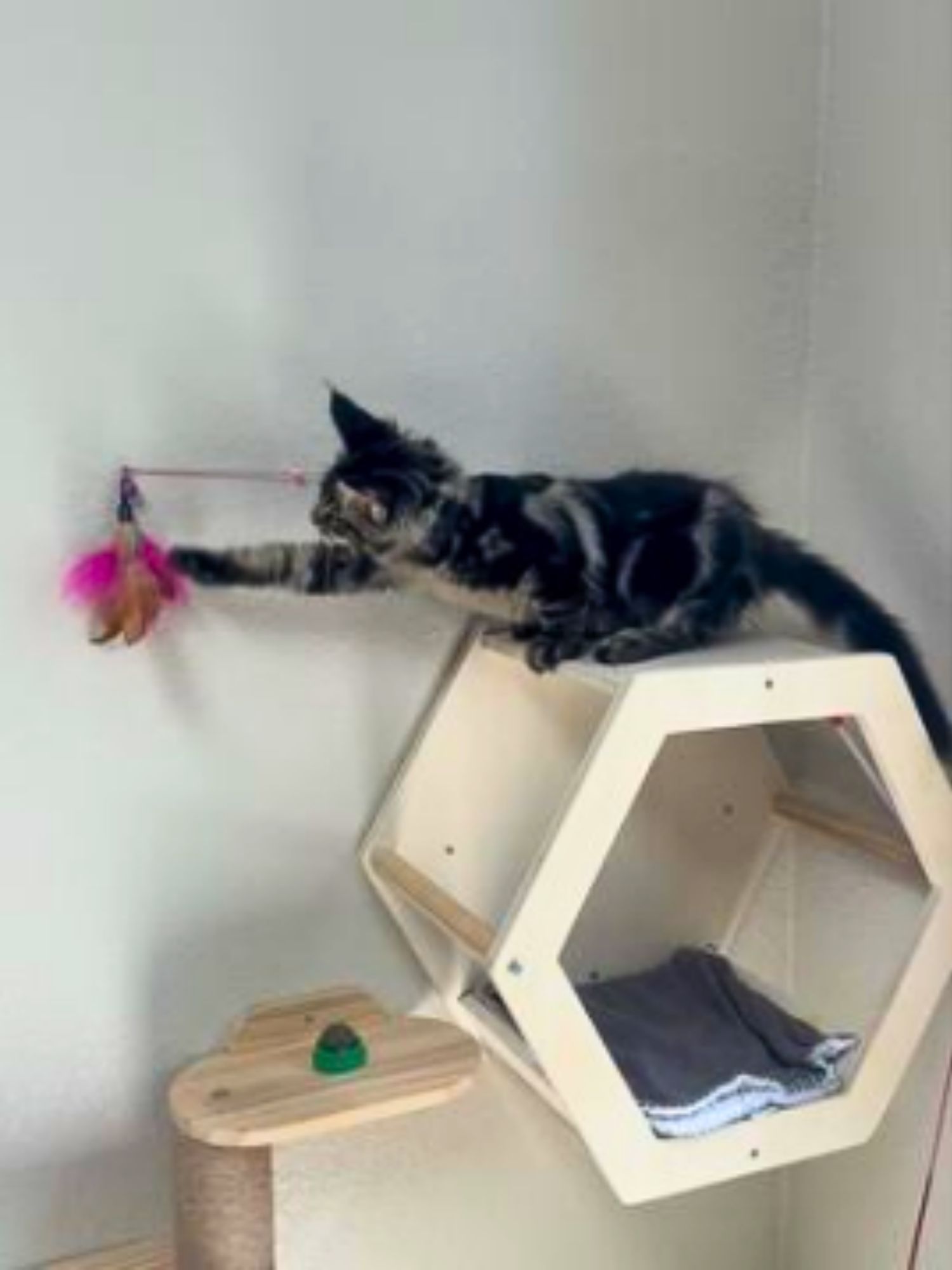 Kong playing up high
Kong playing up highYou can encourage this by placing a vertical pad higher on the wall or hanging a scratcher on a door.
Even a simple cardboard mat secured at eye level can give your cat the satisfaction of a tall tree trunk.
The result is healthier muscles, sharper nails, and fewer attacks on your furniture.
3. Turn Snacktime into Playtime DIY Foraging Toys!
Looking for a fun way to keep your cat entertained and mentally stimulated? Creating DIY foraging toys is a fantastic way to engage your Coonie’s natural hunting instincts, turning snack time into an exciting adventure!
Why Enrichment Matters: Enrichment activities like foraging are great for keeping your cat's mind sharp and preventing boredom.
They mimic the natural hunting behavior, making your cat work a little for their treats, which can help reduce stress and provide mental stimulation.
DIY Foraging Toy Ideas:
1. Egg Carton Puzzle: Save an empty egg carton and place a few small treats in the cups. Close the lid (loosely) and let your cat figure out how to open it. For an added challenge, cover some of the treats with paper balls.
2. Paper Towel Roll Hideaway: Take an empty paper towel roll and fold one end closed. Drop a few treats inside, then fold the other end as well. Your cat will have to bat and chase the roll to get the treats out.
3. Muffin Tin Treasure Hunt: Place treats in the cups of a muffin tin, then cover each treat with a lightweight toy or ball. Your kitty will need to remove the objects to get to the treats underneath.
4. Crinkled Paper Ball: Wrap a few treats in a piece of crumpled paper and toss it to your cat. They’ll have a blast batting it around and unwrapping their prize!
Naturally, you'll want to supervise these activities for safety. 🐱
These simple DIY toys can be made with items you already have at home and offer a great way to keep your Maine Coon(s) active and engaged. Get creative, and watch your kitty enjoy the thrill of the hunt!
4. Hidden Water Stations
An at-home hydration boost
Cats are full of surprises, so why not give them one back? A fun way to encourage hydration is by setting up a hidden water station in your home.
Instead of keeping all the water bowls near the food area, place a second dish somewhere unexpected: a hallway, a guest room, or even a favorite windowsill.
Cats love discovering resources on their own, and the novelty taps into their natural hunting instincts.
What feels to us like a simple extra bowl can feel to them like “new territory unlocked.”
Most cats live in a mild state of dehydration, which over time can contribute to urinary issues or kidney strain.
A few extra sips each day really do add up. Maine Coon owners in particular know how important hydration is for keeping big bodies healthy and joints cushioned.
5. Cats on Leashes - Oh, My!
What do you think about walking cats on leash? I think most of us have tried it, or at least considered it.
It sounds like fun to walk a cat! Leash walking can be safe if done correctly. The key is to ensure they comfortable with the harness and leash, and that you're in a safe, controlled environment.
Start by introducing the harness indoors, letting your cat get used to it gradually. Avoid busy streets or areas with loud noises that might frighten him.
Always keep an eye on your cat's behavior, and never force them to walk if they seem stressed or uncomfortable.
Start by choosing a well-fitted harness designed for cats, as collars can be unsafe. Let her get used to the harness indoors before attaching the leash.
Once they're comfortable, begin with short walks around the house, rewarding them with treats for staying calm. Gradually increase the time and introduce the leash.
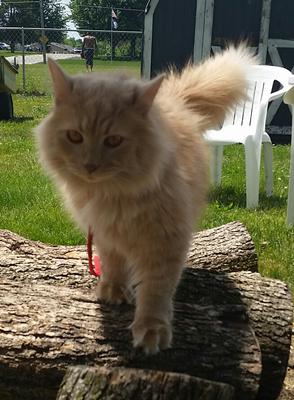 Sammy on his leash
Sammy on his leashWhen your Coonie is ready, try short, calm outdoor sessions in a secure area. Patience is key - some kitties may take weeks to adjust.
Walking your cat on a leash can be a fun and enriching experience for both of you!
It's a great way to give your Coonie some fresh air, exercise and mental stimulation while exploring the great outdoors together.
Not only does it help keep your kitty active and healthy, but it also strengthens the bond between you.
Plus, it's a fantastic way for your cat to safely satisfy their natural curiosity. Why should dogs have all the fun?
When people ask about the daily activity level of a Maine Coon, they're really asking how to keep such a big, bright cat happy. The answer is simple: play, connection, and consistency.
There's so much more to this breed than activity level alone! Hop back to Maine Coon Cats Exposed for the bigger picture on their looks, personality, and care.
